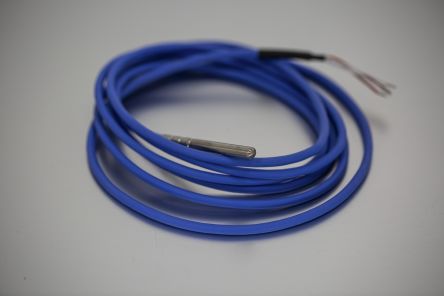
■ 제품필수정보
| 제조사 |
RS PRO |
| 제조사품명 |
PS6/60/PT100/CLA/4FILSSIL/2500 |
| 간략설명 |
RS PRO PT100 RTD Sensor, 6mm Dia, 60mm Long, 4 Wire, Probe, Class A +200°C Max |
■ 제품사양
Sensor
타입 = PT100 Probe Length = 60mm Probe Diameter = 6mm Minimum Temperature Sensed = -20°C Maximum Temperature Sensed = +200°C Termination
타입 = Cable Cable Length = 2.5m Probe Material = Stainless Steel Process Connection = Probe Number Of Wires = 4 Accuracy = Class A Pt100 sensor with stainless steel tip. From RS Pro a high-quality and reliable Pt100 PRT (Platinum Resistance Thermometer) or RTD (Resistance Temperature Detector) sensing probe. This RTD probe has a robust construction with the sensing element encased in a rigid 6mm diameter 316 stainless steel sheath. The leads have a durable and flexible silicone rubber insulation. This platinum resistance thermometer provides accurate and reliable temperature measurement for a wide range of applications. 1 x Pt100 temperature probe, Class A, 4-wire assembly. 316L stainless steel tip, Ø 6 mm, over 60 mm. Sealed fitting, compatible with prolonged immersion. Triple annular crimping allowing immersion on 4-conductor cable. What is an RTD?. An RTD is a type of temperature sensor based on the correlation between metals and temperature. As the temperature of a metal increases so does its resistance to the flow of electricity. This resistance can be measured and converted to a temperature reading. In a Pt100 RTD, the ??Pt ??stands for platinum (platinum wire or film) and ??00 ??means that the temperature sensor has a resistance of 100 Ohms at 0°C. Platinum is the most reliable metal due to its linear resistance to temperature relationship over a large temperature range. What is a Pt100 Probe?. A Pt100 probe is the most rugged form of RTD. The Pt100 temperature sensor element is mounted inside a metal sheath or probe. This protects it from being damaged by the surrounding environment when it is inserted into the process to be measured. The other end of the probe is terminated by 4 insulated wire tails which are connected to the temperature measuring equipment. Features and Benefits. High stability sensing element with a precision output IEC 60751 Class A accuracy/tolerance Temperature measurement range of -20 to +200°C Rigid corrosion resistant 316 stainless steel sheath for protection of sensing element Silicone rubber insulation can withstand a wide temperature range and offers flexibility, resistance to oils and solvents and good weathering properties 4 wire lead tails for an accurate reading Sealed fitting and three ring crimps on sheath to prevent leakage during immersion. Applications. Air conditioning and refrigeration Chemical industry Plastics processing Stoves and grills Air, gas and liquid temperature measurement Exhaust gas temperature measurement Food processing Laboratories. Frequently Asked Questions. How Does a PRT Temperature Sensor Work?. The PRT temperature sensor works by placing the sensor element (or process end) into the equipment or process that requires temperature measurement. As the temperature of the platinum resistance thermometer increases it ??s resistance to the flow of electricity increases. For every increase per degree of temperature the electrical resistance also changes by a set ratio, this is called the temperature coefficient. For platinum, this ratio is .00385 ohm/ohm/°C which means for a Pt100 with a 100 ohm resistance the increase in resistance per degree of temperature would be 0.385 ohms. The total resistance reading can, therefore, be measured and converted into temperature. How is the Resistance Measured?. The resistance generated by the temperature sensor is measured by passing current through one of the wires to produce a voltage. This voltage is then measured using a suitable bridge or voltmeter and the resistance calculated in ohms using Ohm ??s Law (R=V/I). Once the resistance is known you can convert it to a temperature reading using a calibration equation or a Pt100 table. A temperature measurement device or calibrator can also be connected to the leads of the probe that will automatically convert the measured resistance into a temperature reading.





